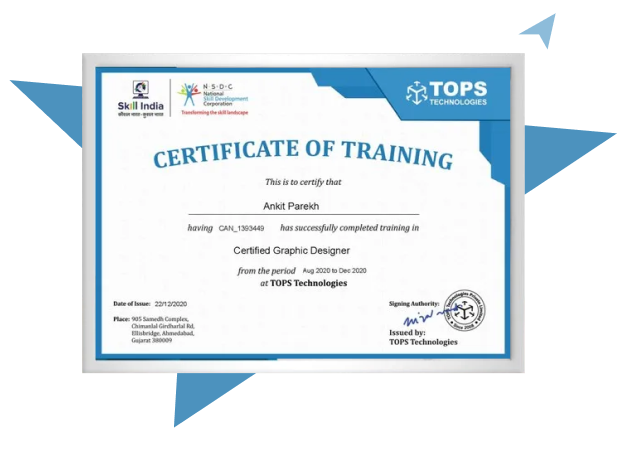Our Facts and Figures
1 Lac+
Student Placed
3000+
Companies TieUp
19+
Offices in India
50+
Industry Courses
Get 100% Job Assistance by enrolling in Certified Manual Testing Training Course
Key Highlights
Limited Students Batch
Personalised Attention
Highly Qualified Teachers
Flexible Batch Timings
Interactive Learning
Live Projects
Career Support
Job Oriented Training
Manual Testing Course Highlights
What is Manual Testing?
Manual testing is a software testing technique that helps in performing several tests on an application or software to check its functionality, usability, performance, and more. You can do it with a set of instructions or pre-defined test cases and methodologies. If you want to become a software testing professional, it is vital to learn about the various testing functionalities and approaches to ensure the best results. A manual testing course can help you develop essential skills and knowledge about the industry to secure your dream job in the IT field.
Why Learn Manual Testing?
This testing technique usually uses high-level test cases that allow testers freedom to explore software issues and enhance the end-user experience. As a professional, it is essential to evaluate the usability of the application accurately. Companies are also looking for testers who know dynamic test design techniques to ensure the best user experiences on various devices. This requires widespread knowledge of various tools and technologies. Manual testing training can help you learn fundamentals, understand the process, know the varied test design techniques, and work practically on live projects to gain a perspective.
Why Choose a Manual Testing Training From TOPS?
TOPS Technologies is India’s leading software training company with certified experts. We provide hands-on training with practical business examples to ensure our learners are up-to-date with the best practices in the industry. Our manual testing course will help you learn the techniques you need to manually test a website or application. You will learn how to detect as many flaws as possible and deliver a perfect project to your client. With our manual testing classes, you will know how to write test plans, develop test cases or test scripts, execute test cases, prepare the test reports and test the fixed defects.
Our Manual Testing Certification Course Offers the Following Benefits:
- A Practical Approach: By enrolling in our manual testing classes, you will work with live projects, practical business cases and get personalized training for the best experience.
- Understand the Fundamentals: You will have the opportunity to learn the fundamental principles of manual testing, explore different bugs, know about software testing levels, and more from qualified instructors.
- Job Placement: We also offer job placement opportunities to help you start working with leading companies and establish a successful career.
Enroll in the Best Manual Testing Course in India!
Whether you are a beginner or a professional, our manual testing training is jammed-packed with the latest technologies for you to establish your career. For more information about the testing certification, fees, and duration, feel free to visit your nearest training center or email us at inquiry@tops-int.com. We have training centers in Ahmedabad, Surat, Rajkot, Vadodara, Gandhinagar & Nagpur.
40%
Average Salary Hike
4.5 Lacs
Highest Salary
3000+
Hiring Partners
Join Our Free Upcoming Webinar
Learn the Website Hacks and Provide Better Security
21 Dec 2025, 04:00 PM
Trainer
Faruk Pathan
(Sr. Technical Trainer)
Learn the Website Hacks and Provide Better Security
23 Dec 2025, 04:00 PM
Trainer
Faruk Pathan
(Sr. Technical Trainer)
Data Science with AI: Tools, Trends and Real-World Use Cases
24 Dec 2025, 03:00 PM
Trainer
Priya Shah
(Sr. Technical Trainer)
Learn Python in 60 Minutes
25 Dec 2025, 04:00 PM
Trainer
Sanket Chauhan
(Sr. Technical Trainer)
AI in Graphic Design – Future of Creativity
26 Dec 2025, 02:30 PM
Trainer
Parth Patel
(Sr. Technical Trainer)
Manual Testing Course Curriculum
Download Curriculum- Introduction to Manual Testing
- Introduction of Students
- Career in Manual Testing
- Working on Project and Assignment
- Using Lab
- Fundamentals
- What is Testing?
- Testing Activities
- Test Objectives
- Objectives and purpose
- When and Why Testing?
- When to start and stop Testing?
- 7 Key Principles of Testing
- Error, Bug, Defects, and Causes of Defects
- Quality, Risk: Types of Risks.
- Test Organization :
- (Tester, Test Leader, Test planning, QA v/s QC, Testing V/s Debugging )
- Test Development Process:
- Introduction, Test Analysis, Test Plan, Strategy, HLR, Script, Scenario, Cases, Traceability Start HLR in Practically
- Fundamental Test Process:
- STLC, Psychology of Testing
- Start TestCase in Practically
- Software Development Model:
- (V-Model and RAD)
- Software Testing Levels:
- Unit Testing, Integration Testing, System Testing, Acceptance Testing, Alpha and Beta Testing, Testing definitions as per ISTQB.
- Start Scenario (Positive / negative) Practically(Minimum 21 scenario)
- Test Design Techniques
- Dynamic Testing :
- Functional and Non Functional Testing
- Black Box Testing Techniques
- White Box Testing Techniques
- Experience-Based Testing Techniques
- Maintenance Testing
- Other Testing :
- Smoke and Sanity
- End to End, Retesting and Regression
- Positive and Negative
- Static Testing (Formal, Informal, Types of Review, Estimation Techniques)
- Start Defect Report
- Agile Testing
Our TOPS Training Centers in India
Course Key Features
Skills Covered
Job Roles
Get Training Certificate by Government
Recognized NSDC/Skill India

- National Skill Development Corporation
- Supported by the vision of PM Shri Narendra Modi
- Certification by NSDC SkillIndia
- Valid for all Jobs and College Training
- International Recognition

Student Reviews
Nandini Parikh
Manual TesterOverall, the Manual Testing course at TOPS Technologies Ahmedabad was a valuable learning experience. The comb...
Read MoreAditya Lunkad
Manual TesterI appreciated the focus on real-world testing workflows. The course explained how testers collaborate with dev...
Read MoreEsha Mukherjee
Manual TesterHands on practice during the Manual Testing training at TOPS Technologies Ahmedabad helped me understand requi...
Read MoreDanish Pathan
Manual TesterThe course curriculum was well organized and beginner friendly. Even without prior technical background, I was...
Read MoreMitali Ghosh
Manual TesterManual Testing course beginners ke liye bohot suitable hai. Step by step teaching style ki wajah se testing co...
Read MoreYashvardhan Tomar
Manual TesterI enrolled in the Manual Testing course at TOPS Technologies Ahmedabad, and it gave me confidence in identifyi...
Read MoreShubhangi Inamdar
Manual TesterThe Manual Testing course helped me build a strong foundation in quality assurance. The assignments were pract...
Read MoreRehan Mirza
Manual TesterThe trainer at TOPS Technologies Ahmedabad explained different types of testing such as functional, regression...
Read MorePallavi Deshpande
Manual TesterWhat I liked most about the Manual Testing course was the hands-on approach. Writing and executing test cases...
Read MoreVihaan Purohit
Manual TesterI had a very positive learning experience during the Manual Testing training at TOPS Technologies Ahmedabad. T...
Read MoreTasneem Rangwala
Manual TesterThe Manual Testing course at TOPS Technologies Ahmedabad provided a clear understanding of software testing fu...
Read MoreNikhil Wagh
Manual TesterMaine Manual Testing course TOPS Technologies Ahmedabad se join kiya, aur training kaafi practical rahi. SDLC,...
Read MoreFAQ
Manual testing is the process of manually checking software for defects without using automation tools. Testers execute test cases, observe system behavior, and compare results against expected outcomes to ensure the application functions correctly.
Manual testing helps detect real-time user experience issues, visual defects, and usability concerns that automation may miss. It plays a critical role in early-stage development, exploratory testing, and when testing complex user interfaces.
Manual testing is best used for exploratory, usability, and ad-hoc testing. It’s ideal for short-term projects, UI-heavy applications, and situations where test cases change frequently, making automation less efficient.
Common types include black box testing, white box testing, exploratory testing, regression testing, and user acceptance testing. Each type targets different aspects of the software to ensure thorough validation.
Verification ensures the product is built correctly by checking documentation, design, and code. Validation checks if the final product meets user requirements through testing and reviews.
Test cases are step-by-step instructions that define how to validate a specific feature or function. They include input data, execution conditions, and expected outcomes, ensuring consistency in testing efforts.
A test plan outlines the testing strategy, objectives, scope, resources, schedule, and deliverables. It guides the testing process and ensures that all requirements are tested systematically.
A bug is an error found during testing. A defect is a deviation from the expected result in the software. While often used interchangeably, “defect” is more common in formal documentation.
Test cases are prioritized based on business impact, critical functionality, user frequency, and risk level. High-priority tests focus on core features and areas prone to defects.
Exploratory testing involves simultaneous learning and test execution without predefined test cases. Testers use their domain knowledge and creativity to uncover unexpected issues in the software.
Interview Questions
Manual testing is the process of manually checking software for defects without using automation tools. Testers execute test cases themselves and evaluate results to ensure the software behaves as expected. It is crucial for finding UI and usability issues and is often the first step in identifying bugs during early development stages.
Effective test cases require a clear understanding of the requirements and specifications. Each test case must include inputs, expected outputs, preconditions, and postconditions. Keeping them simple, traceable, and focused on individual functionalities ensures comprehensive coverage.
A test scenario is a high-level documentation of a functionality or feature that needs to be tested, whereas a test case is a detailed set of steps to verify that functionality. Scenarios are broader in scope, and multiple test cases can be derived from a single scenario.
A test plan outlines the strategy, objectives, resources, and schedule for testing activities. It includes details like scope, test items, environment, responsibilities, and risk assessment. It serves as a roadmap for ensuring that all testing goals are met efficiently.
When faced with unclear requirements, I proactively engage with stakeholders or business analysts to seek clarification. In the meantime, I use exploratory testing to understand the application behavior and prepare tentative test scenarios based on domain knowledge.
Boundary value analysis (BVA) is a black-box testing technique that focuses on testing the boundaries between partitions. For instance, if valid input is between 1 and 100, testers will check values like 0, 1, 100, and 101 to identify potential edge-case defects.
Verification ensures the product is built correctly by checking documents and code through reviews and walkthroughs. Validation ensures the right product is built by testing the actual application against user requirements. Both are essential for quality assurance.
Regression testing is conducted to verify that new code changes have not adversely affected the existing functionality. It is typically done after every major or minor update, bug fix, or enhancement to ensure that the application remains stable.
I prioritize test cases based on business impact, frequently used functionalities, and areas most prone to defects. High-risk and high-usage areas are tested first, followed by medium and low-priority cases, ensuring optimal coverage under time constraints.
Manual testing encompasses various types such as functional, integration, usability, smoke, sanity, regression, exploratory, and user acceptance testing. These types ensure the application meets all technical and business requirements.









